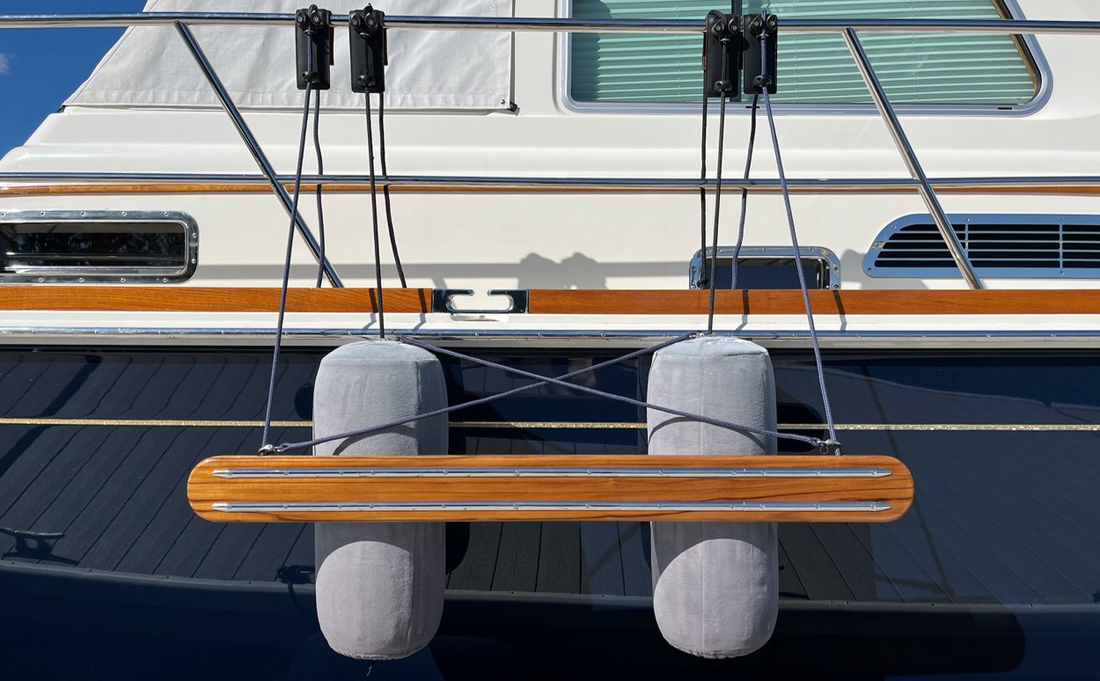Docking is one of the most stressful parts of boating — even for experienced captains. Between shifting winds, tides, and tight marina spaces, a smooth docking can quickly turn into a costly repair if you’re not properly prepared.
Fortunately, these are easy to prevent with the right setup and a few smart habits. Here are some of the most common docking mistakes that lead to hull damage — and how you can avoid them to keep your boat in pristine condition all season long.
Mistake #1: Relying on Too Few Fenders
Many boaters underestimate how much protection they need. One or two fenders may seem fine, but when wind or current pushes your hull against a piling or dock edge, it’s rarely enough.
The fix:
Use multiple fenders positioned along your beam and at points of contact with pilings. For longer docks or rougher conditions, connect them with a fender board — like Fenderboards’ teak models — to distribute pressure evenly and prevent “hot spots” that lead to scuffs or cracks.
Mistake #2: Ignoring Dock Conditions
Every dock is different. Uneven pilings, rough wood edges, or exposed bolts can easily scratch your hull if you’re not paying attention.
The fix:
Inspect the dock before tying up. If the pilings are bare, add piling bumpers or fenderboards for extra protection. When docking at unfamiliar marinas, carry your own system — Fenderboards can be easily deployed anywhere, whether you’re at a floating dock or a fixed pier.
Mistake #3: Misplaced Fenders
Even with plenty of fenders, poor placement can make them useless. Too high, and your hull can slip underneath. Too low, and they may hang below the dock edge where they can’t protect anything.
The fix:
Align your fenders with your boat’s beam and contact points, adjusting height as needed. Use adjustable lines so you can fine-tune position once you’re secure. Fenderboards make this easier by keeping your protection consistent across multiple fenders — especially during tide changes.
Mistake #4: Forgetting About Tides and Water Levels
When docking at a fixed pier, the tide can rise or fall several feet — meaning fenders that were perfectly placed an hour ago may now be hanging too high or low.
The fix:
Plan for vertical movement. Fenderboards move with the boat, maintaining continuous coverage, even when the water level shifts. Combine that with spring lines to prevent your boat from moving too far forward or backward as tides change.
Mistake #5: Skipping Spring Lines
Many boaters tie only bow and stern lines, assuming that’s enough. Without spring lines, your boat can surge forward and back with wakes or wind, scraping the hull against the dock or piling.
The fix:
Always use spring lines at an angle to absorb movement. They act as shock absorbers, reducing the strain on your cleats and keeping your boat stable.
Mistake #6: Neglecting Maintenance
Even the best fenders and boards lose effectiveness if they’re not maintained. Dirty fenders can scratch the gelcoat, and worn lines can snap at the worst time.
The fix:
Rinse your fenders and Fenderboards with fresh water after each use to remove salt and grit. Inspect your hardware, lines, and ties regularly — and replace anything showing signs of wear.
Mistake #7: Docking Too Fast
The golden rule of docking: Never approach the dock faster than you’re willing to hit it. Many minor collisions happen simply because the approach speed was too high for the conditions.
The fix:
Use minimal throttle, approach at a shallow angle, and let wind or current help guide you. If you need to reset — back out, realign, and try again. Fenderboards provide the confidence to maneuver carefully without risking damage.
Avoiding Damage Starts with the Right Protection
At the end of the day, most docking damage happens because of pressure points, poor alignment, or unexpected movement — all problems Fenderboards are designed to solve.
Made from FSC-certified teak and 316 stainless steel hardware, Fenderboards deliver reliable, long-lasting protection against docks, pilings, and seawalls. Their wide coverage area and durable construction give your boat the defense it deserves — and make docking smoother, safer, and stress-free.
Protect your boat before your next trip.
Explore our collection of premium Fenderboards and experience the difference the right gear makes at the dock.

